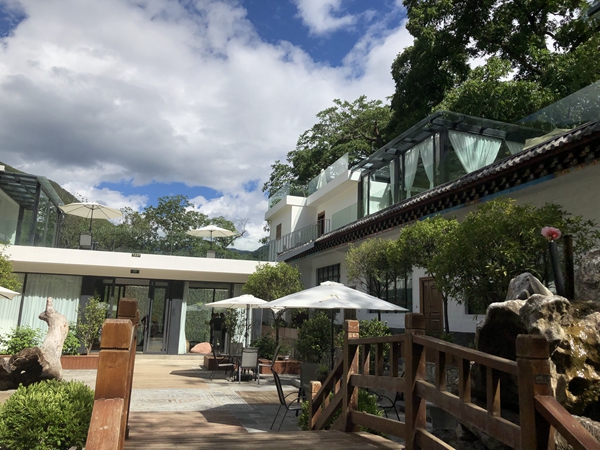Traveling toward prosperity
By Yang Yang | China Daily | Updated: 2020-07-28 07:53

Distinctive allure
The 4,476-square-kilometer county hosts 160,000 people from 28 ethnic groups, including Lisu, Tibetans, Naxi and Pumi. Half of the population is ethnic Lisu.
Paved provincial roads winding around giant mountains like gray ribbons stretch among endless peaks alongside rushing rivers.
As the altitude descends from 3,300 meters in Shangri-La to 1,800 meters in Tacheng, the weather becomes warmer and more humid in summer.
Mountains become flatter and are covered with denser vegetation.
Standing at high points, people can see green valleys in which vineyards framed in by ancient walnut and chestnut trees extend for miles.
Flat mountains crouch like gentle herbivorous dinosaurs whose smooth skin is covered with moss. White clouds pushed by cool breezes through blue skies just above the mountains cast shadows on the terrain. The county is home to orchids, herbs, azaleas and rare Yunnan snub-nose monkeys.
Due to its special geographical location, Weixi has abundant rainfall and sunshine. It's known as "the emerald of the Hengduan Mountains".
Overcoming poverty
But Weixi's residents had long lived in poverty. Most survived by growing grapes, crops, herbs, vegetables and mushrooms on limited land, since mountains jut from 90 percent of its territory. Economic development has been limited since more than half of the area is ecologically fragile.
Before 2019, 70 of the county's 82 villages lived in poverty, with per capita incomes averaging less than 3,750 yuan ($533).
Consequently, tourism is the second pillar industry after farming. But it remains underdeveloped, with only 1,600 residents working in the sector.
Last year, Tacheng received 138,000 tourists, generating about 12 million yuan in revenue.
Dechen, by comparison, received over 22 million visitors in 2019. The government plans to invest in infrastructure and to build villages with unique local elements to develop the travel industry.
Tacheng can "serve as Shangri-La's backyard garden" since a road completed last year reduces travel time between Shangri-La city and Tacheng to 30 or 40 minutes. Tacheng can enjoy the comparative advantages offered by its relatively lower elevation-high humidity and lush forests.
He left Weixi after graduating from middle school at age 16 to work as a guide and driver in such hot tourist destinations in Yunnan as Dali and Lijiang.
He accumulated experience and savings. So, he returned to Tacheng in 2015 because he says he always thought of his hometown, where people were still living in poverty.
Based on his experience, He believes Tacheng's tourism is promising because the forests have been well protected, the air is fresh and the mix of ethnic groups creates a distinctive and rich culture.
Forests cover nearly 87 percent of Tacheng's 807 square kilometers.
People from eight ethnic groups, including Tibetan, Pumi, Naxi and Han, live together, sharing languages, customs and traditions to an extent and in ways rarely seen in other places.
























